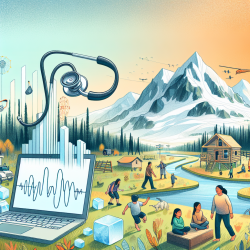Introduction
In the vast and remote landscapes of rural Alaska, the challenge of addressing hearing loss is as significant as the terrain is expansive. The research article "Community Perspectives on Hearing Loss in Rural Alaska" provides invaluable insights into the unique hearing health challenges faced by communities in this region. As practitioners dedicated to improving outcomes for children, we can leverage these findings to enhance our practice and advocate for more effective interventions.
Understanding the Context
The study utilized a mixed methods approach, incorporating both qualitative and quantitative data to explore the etiology, impact, and treatment of hearing loss in 15 communities in the Bering Strait region. This approach ensures ecological validity, meaning the findings are deeply rooted in the real-world experiences of those affected by hearing loss.
Key Findings and Implications
- Etiology: Noise-induced hearing loss and infection-related hearing loss were prominent concerns. Practitioners should be aware of these causes and work towards preventive measures, such as promoting the use of hearing protection during subsistence activities.
- Impact: Hearing loss affects communication, social interactions, and academic performance. Understanding these impacts can guide practitioners in developing comprehensive care plans that address both the medical and social aspects of hearing loss.
- Treatment: The study highlighted the repetitive and often burdensome nature of current treatment pathways. Telemedicine emerged as a promising solution, doubling follow-up rates compared to traditional methods. Practitioners should advocate for and utilize telemedicine to improve access to care.
Actionable Steps for Practitioners
To implement the research findings effectively, practitioners can take the following steps:
- Promote awareness and education about the causes and prevention of hearing loss, particularly in relation to noise exposure and infection management.
- Advocate for the integration of telemedicine in hearing health services to enhance access and reduce travel burdens for families.
- Engage with community stakeholders to ensure interventions are culturally sensitive and contextually relevant.
- Encourage further research to explore innovative solutions and address gaps identified in the study.
Conclusion
By understanding the community perspectives on hearing loss in rural Alaska, practitioners can tailor their approaches to be more effective and culturally appropriate. This study serves as a reminder of the importance of context in health care delivery and the potential of telemedicine to bridge gaps in access. As we strive to create better outcomes for children, let us be guided by data, driven by compassion, and inspired by the resilience of the communities we serve.
To read the original research paper, please follow this link: Community Perspectives on Hearing Loss in Rural Alaska.










